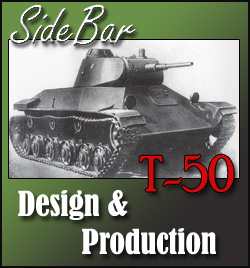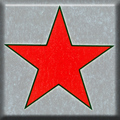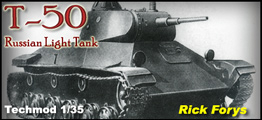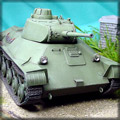The T-50 was a 13-ton vehicle with a crew of four, and was armed with a 45mm main gun
and a 7.62mm coaxial machine gun. Though it was too difficult to mass produce, and not
numerically important, this sleek, streamlined design was a stepping stone to maybe the best
tank of WWII, the T-34.
|
|
This is a kit from the Polish manufacturer Techmod, issued in 1997. As Eastern
European kits go, it is not bad. The detail is a little soft, but very acceptable, and
the parts fit is very good. No real issues here, assembly was straightforward.
However, extra care must be taken to align the suspension parts, as there are no locating pins
or keys. There is also an "up armored" version of the kit, which I understand comes with
a small P/E sheet. A nice work up of that version appears in AFV Modeller #30.
|
|
|
 |
Written information about this tank is about as scarce as pictures. What can be
told is as follows. The T-50 was one of three tanks that contributed to the design of the
legendary T-34. The other two were the A-20, which was an upgraded Christie suspension type,
and the A-32, which was a pure, fully tracked vehicle based on the A-20, with heavier armor, and a
much bigger 76mm gun. In the typical Russian fashion, the T-50 shared the same turret with
the A-20. In testing, it became evident that a pure tracked vehicle was the way to go.
This gave favor to the A-32, however the Red Army Armored Troop Command had issues with the design,
as they favored a longer tank, which could carry more troops on the back. This in turn, led
to the development of the T-50.
Design of the tank actually began in 1939 under the project name "SP", then 126, then T-126 SP.
It was constructed in Leningrad by the Woroszylowa Company using the designation T-50, with delivery to
the Russian army starting in 1941. Fifty units were produced that year, and then production
moved to Omsk, where another 15 units were constructed in 1942. At that point, it was determined
that the design was too complicated and expensive to mass produce, therefore production was halted
after 65 units. As for combat history, it is known that many of the Leningrad produced units
fought against Finland, with a number of those being captured and used by Finnish forces.
|
|






![[]](T50-049b.jpg)
![[]](T50-T05b.jpg)
![[]](T50-045b.jpg)
![[]](T50-056b.jpg)
![[]](T50-006b.jpg)
![[]](T50-024b.jpg)
![[]](T50-027b.jpg)
![[]](T50-028b.jpg)
![[]](T50-077b.jpg)
![[]](T50-078b.jpg)
![[]](T50-173c.jpg)
![[]](T50-174c.jpg)
![[]](T50-182c.jpg)
![[]](T50-114b.jpg)
![[]](T50-175b.jpg)
![[]](T50-180b.jpg)
![[]](T50-177b.jpg)
![[]](T50-187a.jpg)
![[]](T50-184a.jpg)
![[Index]](../../../Redstar3a.jpg)